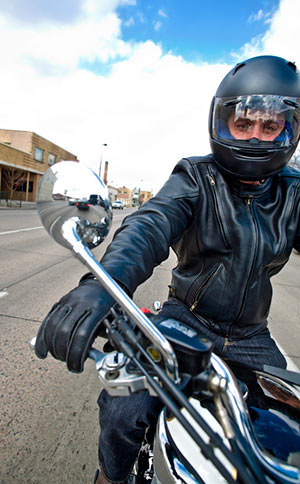victims for over 25 years.
What to Do About Traffic Signals That Ignore Motorcycles
 Everything is getting “smarter” these days. Our phones, our cars, our clothes washers and our televisions. Believe it or not, the same is true of our roads. Yes, autonomous cars are on the horizon but our very roads are also getting smarter as traffic experts attempt to use road data to make our commutes easier and more efficient. One way they do this is through road sensors. But what if these sensors don’t recognize your motorcycle or bicycle? Is it legal to run a red light on a motorcycle when you’ve been sitting there for too long?
Everything is getting “smarter” these days. Our phones, our cars, our clothes washers and our televisions. Believe it or not, the same is true of our roads. Yes, autonomous cars are on the horizon but our very roads are also getting smarter as traffic experts attempt to use road data to make our commutes easier and more efficient. One way they do this is through road sensors. But what if these sensors don’t recognize your motorcycle or bicycle? Is it legal to run a red light on a motorcycle when you’ve been sitting there for too long?
As with everything else, the answer is yes… and no. It depends on which state you’re riding in.
How Long Do You Have to Sit at a Red Light Before You Can Run It?
 Many states now have laws that allow motorcyclists and bicyclists to run a red light if they have been stopped at the intersection for a certain period of time. Each state is different and some are oddly unspecific about the time period, while others make the rules very clear.
Many states now have laws that allow motorcyclists and bicyclists to run a red light if they have been stopped at the intersection for a certain period of time. Each state is different and some are oddly unspecific about the time period, while others make the rules very clear.
For example:
- Arkansas: Motorcyclists can proceed with caution after coming to a full stop through a red light that fails to detect the bike. (No word on how long they have to sit in order to assess the light’s failure to detect.)
- Idaho: A motorcyclist can proceed after coming to a full stop if a signal fails to operate after one cycle of the light. (I like the specificity on how long a motorcyclist needs to wait for a red light to change.)
- Illinois: Motorcyclists who face “a red light that fails to change within a reasonable period of time not less than 120 seconds” may proceed through a red light. (I think it’s better to use the number of times the traffic signal has changed versus seconds on a clock. Who uses a watch while riding a motorcycle?)
Those are just a few examples from the 18 states that have passed so-called “dead red” laws allowing motorcycles to run red lights legally. (To see a full listing, click here.)
Unfortunately, Colorado does not yet have a dead red law to help bicyclists and motorcyclists more safely and legally negotiate their way through intersections that don’t recognize their presence.
Why Are Dead Red Laws Necessary?
If you’re asking that question, you’ve never ridden a motorcycle or bicycle on city streets. Because today’s streets are so “smart,” sensors are now in charge of when traffic lights change. Today, there are two kinds of sensors that alert traffic lights when someone has stopped at an intersection and is waiting for a green light. Unfortunately, they don’t always pick up light-weight vehicles.
How Do Traffic Lights Know to Change?

- Over-the-Pavement Sensors: These sensors include motion-sensing cameras, lasers and infrared fields. Over-the-pavement sensors are designed to “see” vehicles that reach a certain point in the intersection and they are often very good at picking up small vehicles, like motorcycles, bicycles and scooters.
- In-Pavement Sensors: These sensors are typically the culprit when it comes to dead red lights for motorcycles and bicycles. In-pavement sensors usually rely on a vehicle’s weight or metal mass to trigger a scale or magnet. You can sometimes tell if an in-pavement sensor has been added to a road because the asphalt has been cut into a circle or square. Beneath that slab of asphalt lies the sensor that is stubbornly ignoring your bike!
If you live in a state that does not allow you to pass through a red light that refuses to change, you can try to trick the in-pavement sensor. Note the marks on the asphalt that I described above and then position your bike exactly on top of the cut marks. That is where the loop wires rest, connecting to the main sensor. If you’re riding with a buddy, have him or her park on the other side of the saw marks. (For example, if the asphalt was cut in a square, you and your buddy should stop your bikes on top of the left and right arms of the square.)
Turning Left Across a Dead Red Intersection
Now, even in the states where it is legal, I strongly caution you to wait as long as possible before turning left across oncoming traffic when you’re sitting at a dead red light. If you get hit, it will be your fault because you shouldn’t have turned in the first place. (That’s why nearly every state with dead red laws requires motorcyclists to come to a complete stop and proceed only when it’s safe: the onus is on the motorcyclists to assure his or her own safety.)
One more note of caution to those of you who live and ride in states with dead red laws: Don’t abuse them. Just because you’re sitting at a red light doesn’t mean it’s “dead.” Give the light plenty of time to turn green. If bikers start blowing through red lights, behaving as though they have a “free pass” at intersections, they will inevitably make states think twice about these laws.
Should Colorado enact a dead red law for motorcyclists? I’d love to hear from you!
Free Consultation
Search For
Recent Articles
- One Seriously Injured in Lane Violation Accident at E MLK Jr Blvd and N Quebec St
- Bicycle and SUV Involved in Traffic Incident at 15th St and Champa St
- Bicycle and Car Collision Reported at N Pearl St and E 47th Ave
- Pedestrian Hit by SUV in Denver’s Berkeley Neighborhood
- Cyclist Injured in Early Morning Crash with SUV in Denver’s Baker Neighborhood
Categories
- Arvada
- Aurora
- Auto Accident eBook
- Auto Insurance
- Bicycle
- Bicycle/Motorcycle Accidents
- Bodily injury
- Car accidents
- Centennial
- Colorado
- Colorado Legislature
- community
- Denver
- Denver Metro Motor Vehicle Accidents
- distracted driving
- DUI Accidents
- Englewood
- Events
- Flood Insurance
- Fort Collins
- Highlands Ranch
- Hit and Run
- In The News
- insurance companies
- Lakewood
- Littleton
- Marijuana DUI
- Motorcycle Accidents
- Motorcycle Insurance
- Motorcycle Law eBook
- Motorcycles
- Newsletter
- Pedestrian
- Personal Injury Law
- Press Release
- Safe Driving
- Safety
- Scooters
- technology
- Tips
- Uncategorized
- vibrio vulnificus bacteria
- Videos
- Westminster
- Winter Driving
- Wrongful Death
Archive
- July 2025
- June 2025
- May 2025
- April 2025
- March 2025
- February 2025
- January 2025
- December 2024
- November 2024
- October 2024
- September 2024
- August 2024
- July 2024
- May 2024
- April 2024
- March 2024
- February 2024
- January 2024
- December 2023
- November 2023
- October 2023
- September 2023
- August 2023
- July 2023
- June 2023
- May 2023
- April 2023
- March 2023
- February 2023
- January 2023
- November 2022
- September 2022
- April 2022
- March 2022
- February 2022
- January 2022
- December 2021
- November 2021
- October 2021
- September 2021
- August 2021
- July 2021
- June 2021
- May 2021
- April 2021
- January 2021
- December 2020
- November 2020
- October 2020
- September 2020
- August 2020
- July 2020
- June 2020
- May 2020
- April 2020
- March 2020
- February 2020
- January 2020
- December 2019
- November 2019
- October 2019
- September 2019
- August 2019
- July 2019
- June 2019
- May 2019
- March 2019
- February 2019
- January 2019
- December 2018
- November 2018
- October 2018
- September 2018
- August 2018
- July 2018
- June 2018
- May 2018
- April 2018
- March 2018
- February 2018
- January 2018
- December 2017
- November 2017
- October 2017
- September 2017
- August 2017
- July 2017
- June 2017
- May 2017
- April 2017
- March 2017
- February 2017
- January 2017
- December 2016
- November 2016
- October 2016
- September 2016
- August 2016
- July 2016
- June 2016
- May 2016
- April 2016
- March 2016
- February 2016
- January 2016
- December 2015
- November 2015
- October 2015
- September 2015
- August 2015
- July 2015
- June 2015
- May 2015
- April 2015
- February 2015
- November 2014
- October 2014
- September 2014
- July 2014
- June 2014
- May 2014
- April 2014
- March 2014
- February 2014
- January 2014
- October 2012
- September 2012
- August 2012
- July 2012
- February 2012
- March 2011
- October 2010